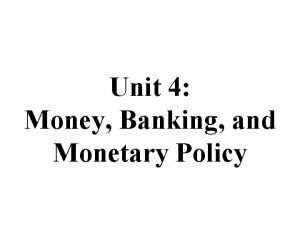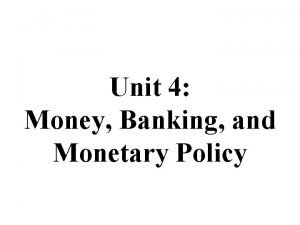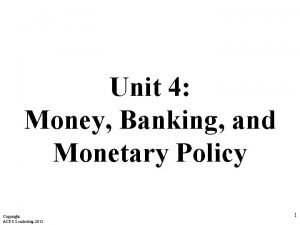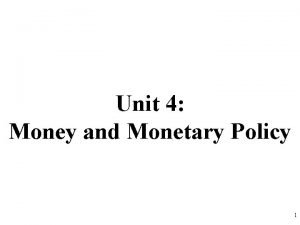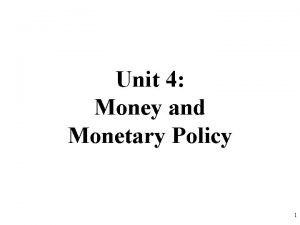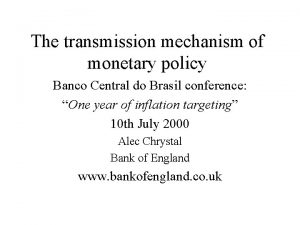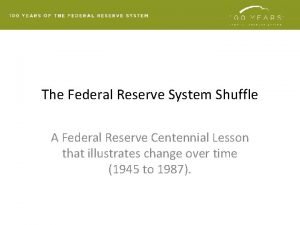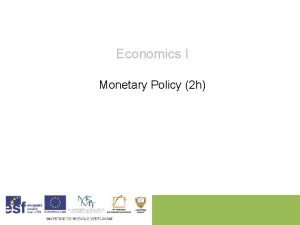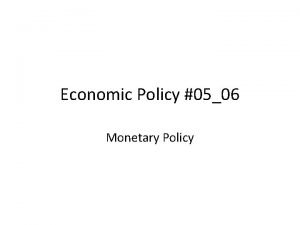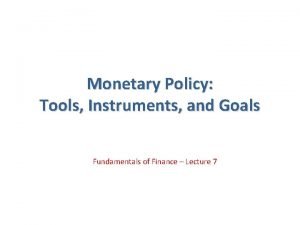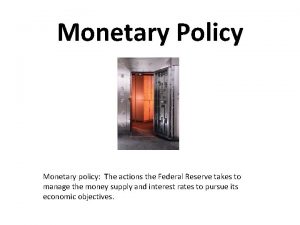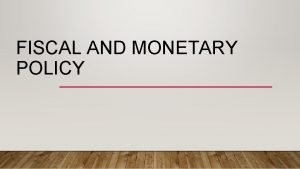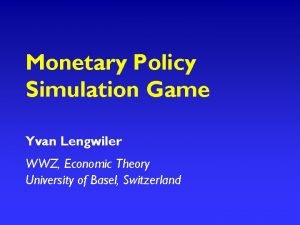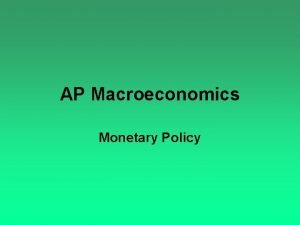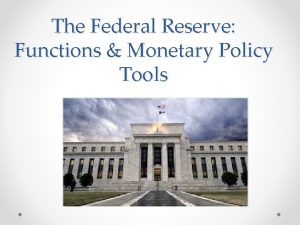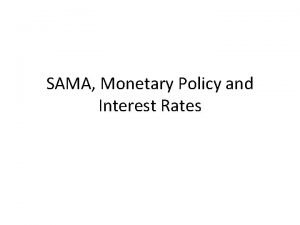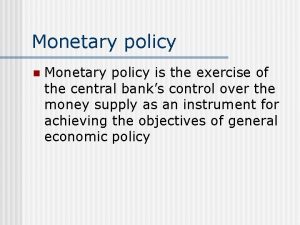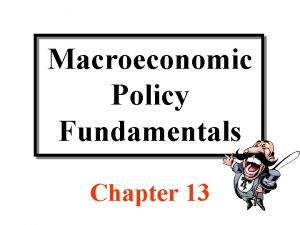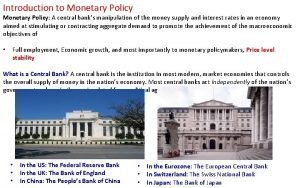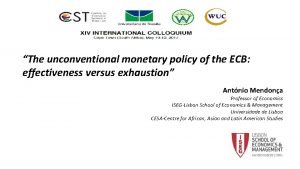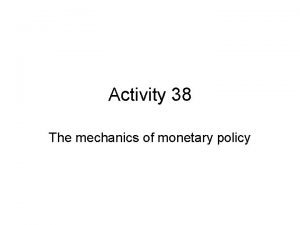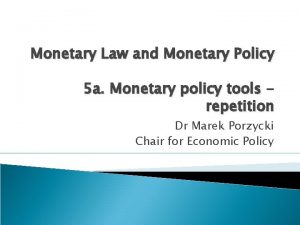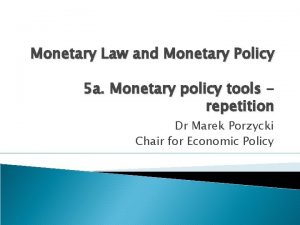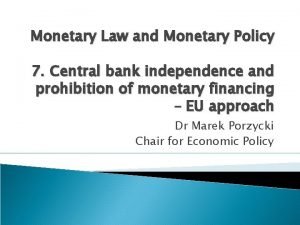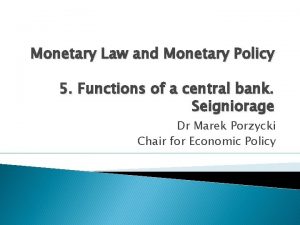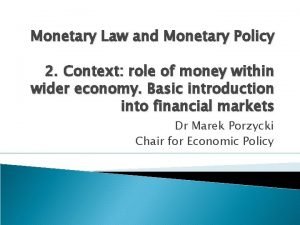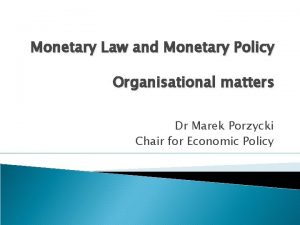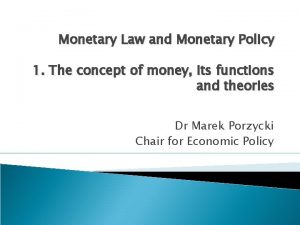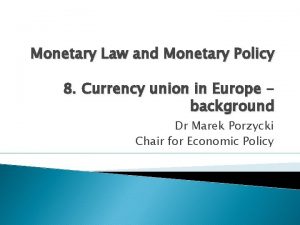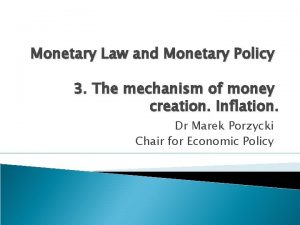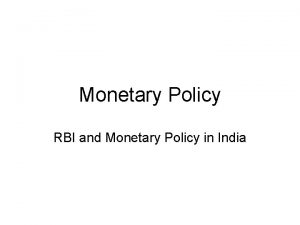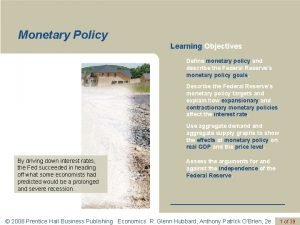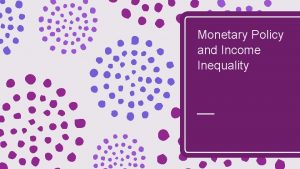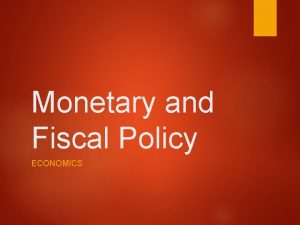Monetary Law and Monetary Policy 4 Monetary policy

































- Slides: 33

Monetary Law and Monetary Policy 4. Monetary policy – instruments and policies Dr Marek Porzycki Chair for Economic Policy

Overview 1. 2. 3. 4. 5. 6. 7. Basic function and purposes Approaches – restrictive vs. expansionary Monetary policy tools Transmission mechanism Unconventional tools applied during current crisis Communication of monetary policy Sources and reading

Basic function of monetary policy Steering the money supply - direct influence on the monetary base (M 0) - indirect impact on monetary aggregates (M 1 and above) via the transmission mechanism

Inflation targetting and its alternatives price stability objective price stability vs other goals of monetary policy economic growth high employment stability on financial markets inflation targetting Note: legal aspects of central bank mandate will be discussed during the following courses

Expansionary vs. restrictive policy - Expansionary (loose) monetary policy – expansion of money supply aiming at higher inflation (or at least accepting it) stimulating economic growth lower interest rates = cheaper lending „doves” Restrictive (tight) monetary policy – reduction of money supply aiming to reduce inflation cooling down overheated economy higher interest rates = more expensive lending „hawks”

Reserve requirement - a specified fraction of deposits kept with a commercial bank to be set aside in the central bank as mandatory reserve deposits set aside as reserve cannot be used to finance lending reduction of the money multiplier Current values (as of 2. 4. 2013): Poland: 3, 5 % - 500. 000 EUR per credit institution euro area: 1% - 100. 000 EUR per institution

Reserve requirement - example Starting from 18. 01. 2012, the ECB has lowered the reserve requirement from previous 2% to 1% as one of measures intended to support bank lending ( expansionary monetary policy) press release: http: //www. ecb. int/press/pr/date/2011/htm l/pr 111208_1. en. html However, this move did not reach its intended goal, as commercial banks preferred to deposit excess reserves at the ECB using the deposit facility.

Standing facilities Central bank acts as „bank of banks” taking deposits and extending loans to commercial banks. Central bank acts as „lender of last resort” providing liquidity to disstressed (but solvent) banks. „standing” = can be used at the commercial banks’ initiative

Standing facilities - lending primary credit or regular short-term lending (usually overnight) - Eurosystem: marginal lending facility - Fed: discount window - NBP: lombard loans (kredyt lombardowy) in usual conditions interest rate applied to central bank lending sets a ceiling on interbank interest rates current rates (2. 4. 2013): 1, 50% (ECB), 4. 75% (NBP) to be distinguished from secondary lending or liquidity support see below, unconventional tools

Standing facilities - deposits overnight deposits with the central bank, available to commercial banks Interest rate on overnight deposits sets floor to interbank lending rates, as the deposit facility allows banks to „park” any amount of money at the central bank at the deposit rate Deposit rate is the lowest of central bank interest rates. Current ECB interest rate on deposit facility (as of 2. 4. 2013): 0, 00% Corresponding NBP rate: 1, 75%

Open market operations initiated by the central bank Basic form: purchases or sales of assets (mostly Treasury bonds) from financial institutions Purchases of assets expansion of monetary base, providing liquidity Sales of assets shrinking of monetary base, absorbing liquidity Dynamic vs. defensive open market operations Repos (repurchase agreements) and reverse repos – purchases/sales reversed on a specified time, subject to specified interest rate Outright transactions (purchase/sale without an agreement to reverse the transaction)

Open market operations 2 - Other instruments used – collateralised loans, issuance of debt certificates by the central bank, swaps, fixed-term deposits Difference in aims and regularity (Eurosystem examples): main refinancing operations long-term refinancing operations (LTRO, see also unconventional monetary policy) fine-tuning operations (conducted on an ad hoc basis) structural operations

Open market operations - example From the ECB website Date: 28/03/2013 Action: Fine-tuning operation Communication: [… T]he ECB conducts specific operations in order to re-absorb the liquidity injected through the Securities Markets Programme (SMP). In this regard, the ECB will carry out a quick tender on 2 April at 11. 30 in order to collect one-week fixed-term deposits with settlement day on 3 April. A variable rate tender with a maximum bid rate of 0. 75% will be applied and the ECB intends to absorb an amount of EUR 205. 5 billion. […]. Fixed term deposits held with the Eurosystem are eligible as collateral for the Eurosystem's credit operations. The ECB intends to carry out another liquidity-absorbing operation next week.

Eligible collateral Lending by central banks should be based on adequate collateral (assets submitted by commercial banks as security). Treasury bonds and other marketable assets (e. g. credit claims) are usually used as collateral. Central banks maintain a list of eligible collateral and update it from time to time (example: http: //www. ecb. int/paym/coll/assets/html/list. en. html) Risky collateral, e. g. bonds with lower credit risk rating, may be eligible under certain circumstances but valuation haircuts may be applied to reflect higher risk. Example: use of Greek sovereign bonds as collateral for Eurosystem monetary policy operations

Eligible counterparties - Institutions allowed to contract with the central bank within the monetary policy framework. Broadly: commercial banks and similar institutions. Eurosystem eligibility criteria – eligible institutions should be: subject to minimum reserve requirement in financially sound condition subject to financial supervision by competent authorities fulfilling operational criteria

Central bank interest rates Interest rates applied by central banks to respective monetary policy instruments. Announced by the central banks and changed in reaction to monetary policy needs: rate increase – tightening the monetary policy, aimed at reduction of the money supply rate decrease – easing the monetary policy, aimed at expansion of the money supply Influence on conditions on the money market (interbank and between banks and the general public) and in the general economy via the transmission mechanism.

Central bank interest rates Examples: ECB http: //www. ecb. int/home/html/index. en. html („Key figures at a glance”) http: //www. ecb. int/stats/monetary/rates/html /index. en. html NBP http: //www. nbp. pl/home. aspx? f=/srodek. htm („Stopy procentowe NBP”) http: //www. nbp. pl/home. aspx? f=/dzienne/sto py. htm

Assessment of the respective monetary policy tools Reserve requirements - useful as a limit of possible money creation but not suitable for rapid changes in answer to changing conditions on the market. Standing facilities – useful to influence interest rates on the market but not suitable for reacting to daily fluctuations. Open market operations – more flexible, initiated by the central bank at any time and with any volume needed. Easily reversible.

Transmission mechanism function of „bank of banks” central banks deal directly only with commercial banks but not with the general public. Proper functioning of the monetary policy requires transmission of measures taken by the central bank through commercial banks to the economy. Transmission channels include credit and deposit businesses of the commercial banks, asset prices, currency exchange rates and indirectly also wage and price-setting resulting from supply and demand of goods, services and labour. Transmission mechanism is affected by events beyond control of the central bank, such as global economic developments, commodity prices, political events etc.

Transmission mechanism 2 Source: ECB, http: //www. ecb. europa. eu/mopo/intro/transmission/html/index. en. html

Transmission mechanism 3 Specific problems with transmission of expansive monetary policy in periods of recession. „Zero interest rate policy” („ZIRP”) further lowering of interest rates is not possible, as rates cannot be negative. Expanding the monetary base does not increase money supply as long as banks do not start credit expansion. Monetary policy alone is not able to kick-start economic growth. compared to „pushing on a string”

Unconventional tools crisis-related, extremely expansive monetary policy in order to stimulate economic growth applied when interest rate cuts have failed to stimulate monetary expansion („pushing on a string”) and further cuts are impossible (zero interest rates) asset purchases - quantitative easing (QE) open market operations – LTRO liquidity support – e. g. Emergency Liquidity Assistance (acting as „lender of last resort”) commitment to further actions

Quantitative easing Central banks purchase large volume of assets (mostly Treasury bonds) from banks, creating new money to pay for them. As banks buy Treasury bonds in order to re-sell them to the central bank, QE is sometimes considered to circumvent the prohibition on monetary financing (lending by the central bank to the Treasury). Purchases of Treasury bonds by the central bank are legal if occuring on the secondary market, but prohibited on primary market (directly from the Treasury). Result: large expansion of the monetary base (M 0) first applied in Japan since 2001, then by several central banks after 2007

Liquidity support secondary lending or liquidity support - Eurosystem: Emergency Liquidity Assistance (ELA) providing liquidity to solvent banks experiencing liquidity problems (e. g. withdrawal of deposits, lack of access to interbank lending). function: preventing bank runs. Not applicable to insolvent banks which should be subject to bank resolution tools or insolvency proceedings.

Liquidity support – recent example On 21. 3. 2013 the ECB announced that Emergency Liquidity Assisstance to Cypriot banks would be continued only until 25. 3, unless a programme to ensure their solvency is put in place. http: //www. ecb. int/press/pr/date/2013/html/pr 130 321. en. html On 25. 3 a bailout deal was reached between Cyprus and the Eurogroup (Eurozone finance ministers). On 25. 3 the ECB decided to continue providing ELA to Cypriot banks, based on the assumption that the bailout maintained their solvency. http: //www. ecb. int/press/pr/date/2013/html/pr 130 325. en. html

Commitment to further action Function: sending signals to the markets Example: speech by Mario Draghi, President of the ECB, on 26. 7. 2012 „Within our mandate, the ECB is ready to do whatever it takes to preserve the euro. And believe me, it will be enough. ” http: //www. ecb. int/press/key/date/2012/html/sp 12 0726. en. html Understood as commitment to unlimited asset purchases. Follow-up: launch of Outright Monetary Transactions on 6. 9. 2012 http: //www. ecb. int/press/pr/date/2012/html/pr 120 906_1. en. html

Will QE cause inflation? Does QE mean „printing money”? QE and other forms of unconventional monetary policy result in a large expansion of central banks’ balance sheets expansion of monetary base (M 0) However, inflation results from the increase of total money supply, including not only M 0 but mostly money created by commercial banks (M 1, M 2). As banks mostly deposited additional funds obtained from QE as deposits in the central banks (excess reserves), lending expansion did not occur and there was no increase in total money supply.

Will QE cause inflation? 2 As long as commercial banks do not start credit expansion using the expanded monetary base, overall money supply remains low and inflation does not result. Once credit expansion starts, central banks would need to restrict monetary policy, including shrinking the monetary base in order to avoid inflation („exit strategy”). Too early tightening of the monetary policy could push the economy into deep recession. In case of a too late tightening, inflation can result from current expanded monetary base being used to finance lending.

Communication with the public and managing expectations In order to be efficient, monetary policy needs to be predictable. explaining monetary policy in detail to the general public publishing long-term strategies and policies declaring „approaches” in monetary policy regular meetings of the rate-setting bodies, followed by press conferences publication of minutes of discussion of the rate-setting bodies

Communication - examples „Monetary Policy Guidelines” – a yearly strategy document by the NBP http: //www. nbp. pl/en/publikacje/o_polityce_ pienieznej/zal 2013 a. pdf ECB communication channels explained: http: //www. ecb. int/mopo/strategy/comm/ht ml/index. en. html

Additional reading and reference materials F. Mishkin, The Economics of Money, Banking, and Financial Markets, Pearson, 10 th ed. 2013 monetary policy tools, p. 418 -431 price stability and other goals: Chapter 17, p. 434 -454 ECB website http: //www. ecb. int/mopo/html/index. en. html NBP website http: //www. nbp. pl/homen. aspx? f=/en/onbp/informacje/p olityka_pieniezna. html Fed website http: //www. federalreserve. gov/monetarypolicy/default. ht m For Polish readers: A. Sławiński (red. ), Polityka pieniężna, Warszawa 2011

ECB General Documentation most comprehensive and detailed description of the Eurosystem monetary policy „The implementation of monetary policy in the euro area. General documentation on Eurosystem monetary policy instruments and procedures” – set in annex to the ECB Guideline of 20. 9. 2011 on monetary policy instruments and procedures of the Eurosystem (recast) (ECB/2011/14) http: //www. ecb. int/ecb/legal/pdf/02011 o 00 14 -20130103 -en. pdf

On a lighter note… Try yourself in monetary policy – €CONOMIA - The Monetary Policy Game on the ECB website: http: //www. ecb. europa. eu/ecb/educational/e conomia/html/index. en. html
 Newton's first law and second law and third law
Newton's first law and second law and third law Si unit of newton's first law
Si unit of newton's first law Unit 4 money banking and monetary policy
Unit 4 money banking and monetary policy Unit 4 money banking and monetary policy
Unit 4 money banking and monetary policy Fiscal policy effect on interest rates
Fiscal policy effect on interest rates Unit 4 money and monetary policy
Unit 4 money and monetary policy Unit 4 money and monetary policy
Unit 4 money and monetary policy Unit 4 money and monetary policy
Unit 4 money and monetary policy Transmission of monetary policy
Transmission of monetary policy Lesson quiz 16-1 monetary policy
Lesson quiz 16-1 monetary policy Objectives of monetary policy
Objectives of monetary policy What is the meaning of monetary policy
What is the meaning of monetary policy Types of monetary policy
Types of monetary policy What are the objectives of monetary policy
What are the objectives of monetary policy Objectives of monetary policy
Objectives of monetary policy Money includes
Money includes Three tools of monetary policy
Three tools of monetary policy Monetary policy summary
Monetary policy summary Fiscal vs monetary policy
Fiscal vs monetary policy Monetary policy simulation game
Monetary policy simulation game Types of monetary policy
Types of monetary policy Instruments of monetary policy
Instruments of monetary policy Inflation
Inflation Explain moral suasion
Explain moral suasion Ano ang tight money policy
Ano ang tight money policy Sama exchange rate
Sama exchange rate Instruments of monetary policy
Instruments of monetary policy Expansionary monetary policy flow chart
Expansionary monetary policy flow chart Monetary policy
Monetary policy Expansionary monetary policy
Expansionary monetary policy Expansionary money policy examples tagalog
Expansionary money policy examples tagalog Features of fiscal policy ppt
Features of fiscal policy ppt Ecb unconventional monetary policy
Ecb unconventional monetary policy Monetary policy baseline
Monetary policy baseline


